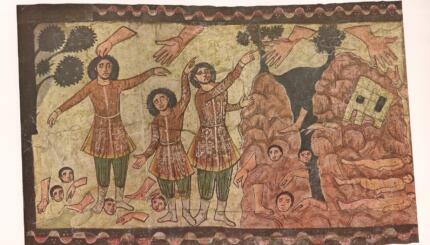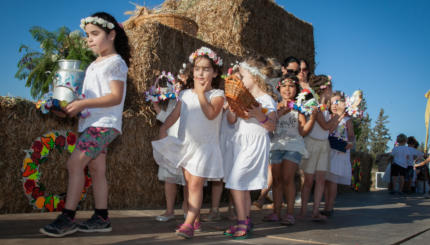Shavuot celebrates the first barley harvest and also the giving of the Torah on Mount Sinai—the moment when Israel accepted all of God’s law. There are several biblical texts read on this holiday.
The Book of Ruth
Ruth is read during the morning services of Shavuot (on the second day for those observing two days). The titular heroine, a Moabite woman, is married to an Israelite man who dies suddenly. Rather than return to her Moabite family, she follows her Jewish mother-in-law, Naomi, back to Bethlehem. Her declaration of fidelity to Naomi and the Jewish people is beautiful and moving:
“Wherever you go, I will go; wherever you lodge, I will lodge; your people shall be my people, and your God my God. Where you die, I will die, and there I will be buried. Thus and more may the LORD do to me if anything but death parts me from you.” Ruth 1:16-17
In Bethlehem, Ruth is as good as her incredible words; she faithfully cares for Naomi, even in hard times. Ruth goes on to remarry (to another Israelite man) and ultimately becomes the matriarch of one of the great kings of Israel, King David.

Help us keep Jewish knowledge accessible to millions of people around the world.
Your donation to My Jewish Learning fuels endless journeys of Jewish discovery. With your help, My Jewish Learning can continue to provide nonstop opportunities for learning, connection and growth.
We read Ruth for a few reasons. First, Ruth’s pledged fidelity to Naomi and the Israelite God mirrors the fidelity Israel expresses to God upon receiving the Torah. Second, Ruth’s story takes place during the season of the barley harvest, the agricultural occasion for Shavuot. Finally, Ruth is the great-great-grandmother of King David, who is thought to have been born and died on Shavuot.
Torah Readings for Shavuot
Day 1: The Torah reading for the first day of Shavuot, Exodus 19:1–20:23, recounts the exciting moment of Revelation. The children of Israel are encamped at the base of Sinai while Moses ascends the mountain to receive God’s law. God descends to the top of the mountain amidst tumultuous thunder and lightning, smoke, and the blast of the shofar to deliver the Torah. The ten commandments are part of this Torah reading, and it is customary to stand when they are recited.
Day 2: The reading for the second day of Shavuot, Deuteronomy 14:22–16:17, gives the detailed laws for the three pilgrimage festivals: Passover, Shavuot, and Sukkot.
Haftarah (Prophetic) Readings for Shavuot
Day 1: The haftarah for the first day of Shavuot, Ezekiel 1:1-28, recounts the prophet’s ecstatic vision of the divine chariot—God’s brilliant, burning, super vehicle. Just as Israel came close to catching a glimpse of the divine at Sinai, Ezekiel came close to seeing God in this iconic vision.
Day 2: The haftarah for the second day of Shavuot, Habakkuk 2:20-3:19, contains the prophet’s vision of God marching with all the divine hosts to overthrow Israel’s enemy—another vision of the divine that is reminiscent of the encounter at Sinai. The language here is also indebted to the language that describes the revelation at Sinai.
See more here.



